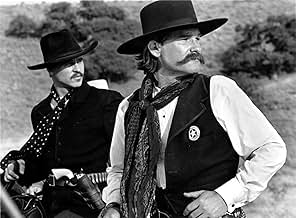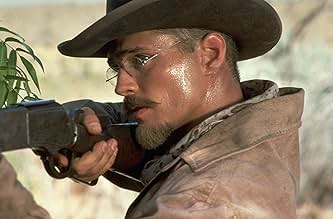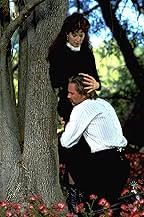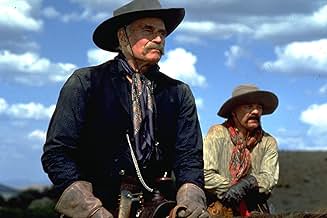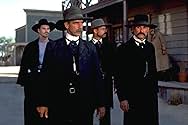Un avocat prend sa retraite dans l'anonymat à Tombstone en Arizona, mais voit ses projets perturbés par le genre de hors-la-loi qu'il éliminait habituellement.Un avocat prend sa retraite dans l'anonymat à Tombstone en Arizona, mais voit ses projets perturbés par le genre de hors-la-loi qu'il éliminait habituellement.Un avocat prend sa retraite dans l'anonymat à Tombstone en Arizona, mais voit ses projets perturbés par le genre de hors-la-loi qu'il éliminait habituellement.
- Prix
- 2 nominations au total
Avis en vedette
First of all, I love the movie. Now some may say, "What a moron..." and others will undoubtedly agree with me. But I think it's great. When I first saw the film as it debuted in theaters eleven or so years back, I came away thinking, Men doing a man's job. Sounds a little chauvinist, I'll admit, but there you are. The movie is a tribute to men being men, living their lives on their own terms. The fact that the story is about the Earp saga is almost secondary to the film. To enjoy this movie, I don't think that it's so important for it to have historical accuracy to the letter or even have rain falling consistently through the shots. I would only advise viewers to let this Remington-painting-come-to-life wash over them and just go along for the ride. As long as we remember that this is Hollywood, all is well.
Then there's reality. As real aficionados of Tombstone history will see, the movie sacrifices or distorts some of the facts and compresses time. In the end it's a shame, really, because the film never realizes its full potential. I'm convinced that if this movie was true to history, it could only have been better. Previous reviews talk about and compare with Costner's Wyatt Earp. I think elements of both films combined would have made a great movie. For instance, I would have lifted much of WE's script from when Wyatt arrives in town (the story, not the dialog) and used it in Tombstone. And then get the rest of the facts straight. The true story is compelling on its own, and would still be entertaining.
The special edition DVD includes deleted scenes, that for the life of me, I can't figure out why they were deleted in the first place. But the scene when Wyatt and Josie rest after their spirited ride still has the payoff of the scene cut out - Josie and Wyatt getting it on. I get tired of directors thinking that the audience is sophisticated so we'll just let them figure it out on their own. Come on George, some of us didn't know that Wyatt was cheating on Mattie.
Finally, I've got to say that the movie was cast well. And the costumes were true to life - men liked to be colorful and unique in that time and place. The guns were accurate, as were the holsters (low slung and quick draw is a Hollywood invention). As for the scenery, I lived in Arizona for a while, and I do miss the big sky.
If you want to be entertained, this is the movie for you. If you want a history lesson, better hit the library...
Then there's reality. As real aficionados of Tombstone history will see, the movie sacrifices or distorts some of the facts and compresses time. In the end it's a shame, really, because the film never realizes its full potential. I'm convinced that if this movie was true to history, it could only have been better. Previous reviews talk about and compare with Costner's Wyatt Earp. I think elements of both films combined would have made a great movie. For instance, I would have lifted much of WE's script from when Wyatt arrives in town (the story, not the dialog) and used it in Tombstone. And then get the rest of the facts straight. The true story is compelling on its own, and would still be entertaining.
The special edition DVD includes deleted scenes, that for the life of me, I can't figure out why they were deleted in the first place. But the scene when Wyatt and Josie rest after their spirited ride still has the payoff of the scene cut out - Josie and Wyatt getting it on. I get tired of directors thinking that the audience is sophisticated so we'll just let them figure it out on their own. Come on George, some of us didn't know that Wyatt was cheating on Mattie.
Finally, I've got to say that the movie was cast well. And the costumes were true to life - men liked to be colorful and unique in that time and place. The guns were accurate, as were the holsters (low slung and quick draw is a Hollywood invention). As for the scenery, I lived in Arizona for a while, and I do miss the big sky.
If you want to be entertained, this is the movie for you. If you want a history lesson, better hit the library...
As a Tucson Native, I was totally impressed. Most people from other parts of the world will believe any western with a saguaro in it. This movie is one of the best of all time, and I worked at Old Tucson. If you're looking for a historical timeline, forget it. It's condensed for dramatic purposes, but still it flows, it's got love, action, comedy(mostly Kilmer) and a serious story of what the old west really was like. Amen for this one as opposed to the tragic The Quick and the Dead which was kinda silly if your brain is turned on whilst watching it. Watch for Priestly's, um, unusual performance. It also has a great back story on Earp's life, which makes for much more than a shallow shoot'em up movie.
A late entry in the western genre when already not too many were being made, this is one of those re-watchable mini-epics, with strong entertainment value. It begins with a bang, an intense shoot-out after some supposedly historical footage narrated by actor Mitchum. We are introduced to The Cowboys, this era's version of the Mafia, led by the charismatic Curly Bill (Boothe). These first few minutes manage to unnerve and surprise the audience right away: we are also introduced to the psychotic gunslinger, Ringo (Biehn), but he's revealed as the most dangerous of the bunch only after the shoot-out, a sleight of hand by the filmmakers - they made him look sympathetic in those early moments while everyone is blasting away and he just stands there looking dazed and bothered. Only afterward do we realize he's a lethal lunatic of the damned - it's a powerful beginning.
It's amazing how well this film turned out considering all the rumors of a troubled history. Credit must be given to director Cosmatos and the actors. It's a fairly huge cast, with numerous speaking roles, and everyone seems to have at least one good moment during the story. Then there's Kilmer as Doc, who is good or great in every scene he's in - this is easily Kilmer's best role. Doc is already sick as the movie begins but he manages to stay in the game to the very end, more dangerous than any 2 cowboys, using supernatural willpower & sardonic wit to distract everyone and himself from the fact he's nearly a walking ghost. Russell is just super-solid as Wyatt; he conveys a strength, tapped from unknown sources (whereas Doc draws from within), standing tall when other tough guys quake in the knees. These two make a terrific team; it's not the usual buddy stuff of most pictures. All the supporting cast is fine, including Elliott and Paxton as Wyatt's brothers, though there are some overly obvious moments. Earp's on - off relationship with the actress (Delany) has its ups & downs, there's not much room for subtlety as Earp's wife looks on quite upset as Delany strikes another of her bemused expressions. Also, due to the large number of characters, some of their stories have a heavily truncated feel (Priestley's, for example). The Vista director's cut special edition DVD has some restored footage to improve this problem. The better scenes are the confrontations between the men, the threats swung high & low, and the sheer thrill of watching Russell slap an overweight Billy Bob Thornton silly.
And we have the villains, ah yes, the villains. I've already mentioned a couple of them - another one is Lang as Ike Clanton in a deliciously cheesy, hammy yet mesmerizing performance. By the last 3rd of the movie, I was so wishing he would get his - please, someone - Earp, Holliday, anyone ! - blow this bastard away! Ike is one of the great unsung villains of movie history, a tribute to Lang's abilities. The conflict in this true-life story stemmed from the notion that there were no real villains. It was a matter of which faction had the rights, based on gun power and political ambition. In other words, the Earps were just making a political power play in the view of some and there was little difference between them and The Cowboys. But this film wastes no time in establishing Wyatt and his brothers as the decent side of the coin and when you have characters like Ike, there's no mistaking which side are the bad guys. For a different take on this piece of history, check out the original Star Trek episode "Spectre of the Gun" from '68. Oh yeah, there are also other films like the Lancaster - Douglas opus from 1957. But the Gunfight at the OK Corral in "Tombstone" was just one set piece out of many.
It's amazing how well this film turned out considering all the rumors of a troubled history. Credit must be given to director Cosmatos and the actors. It's a fairly huge cast, with numerous speaking roles, and everyone seems to have at least one good moment during the story. Then there's Kilmer as Doc, who is good or great in every scene he's in - this is easily Kilmer's best role. Doc is already sick as the movie begins but he manages to stay in the game to the very end, more dangerous than any 2 cowboys, using supernatural willpower & sardonic wit to distract everyone and himself from the fact he's nearly a walking ghost. Russell is just super-solid as Wyatt; he conveys a strength, tapped from unknown sources (whereas Doc draws from within), standing tall when other tough guys quake in the knees. These two make a terrific team; it's not the usual buddy stuff of most pictures. All the supporting cast is fine, including Elliott and Paxton as Wyatt's brothers, though there are some overly obvious moments. Earp's on - off relationship with the actress (Delany) has its ups & downs, there's not much room for subtlety as Earp's wife looks on quite upset as Delany strikes another of her bemused expressions. Also, due to the large number of characters, some of their stories have a heavily truncated feel (Priestley's, for example). The Vista director's cut special edition DVD has some restored footage to improve this problem. The better scenes are the confrontations between the men, the threats swung high & low, and the sheer thrill of watching Russell slap an overweight Billy Bob Thornton silly.
And we have the villains, ah yes, the villains. I've already mentioned a couple of them - another one is Lang as Ike Clanton in a deliciously cheesy, hammy yet mesmerizing performance. By the last 3rd of the movie, I was so wishing he would get his - please, someone - Earp, Holliday, anyone ! - blow this bastard away! Ike is one of the great unsung villains of movie history, a tribute to Lang's abilities. The conflict in this true-life story stemmed from the notion that there were no real villains. It was a matter of which faction had the rights, based on gun power and political ambition. In other words, the Earps were just making a political power play in the view of some and there was little difference between them and The Cowboys. But this film wastes no time in establishing Wyatt and his brothers as the decent side of the coin and when you have characters like Ike, there's no mistaking which side are the bad guys. For a different take on this piece of history, check out the original Star Trek episode "Spectre of the Gun" from '68. Oh yeah, there are also other films like the Lancaster - Douglas opus from 1957. But the Gunfight at the OK Corral in "Tombstone" was just one set piece out of many.
TOMBSTONE, one of two epic westerns about Wyatt Earp released within a few months of each other (1993-94) lacks the lyrical, 'warts-and-all' quality of Kevin Costner's WYATT EARP, but is a more successful film, with tighter pacing, more clearly drawn characters, and a reverence to the genre that has made it the most popular Western of the last twenty years.
From the opening scene, narrated by the legendary Robert Mitchum, a nod to the great Hollywood Westerns of the past is evident; a gang of outlaws calling themselves 'The Cowboys' break up a Mexican wedding in a small town, ruthlessly killing nearly all the men, including village priest Pedro Armendáriz Jr. (son of the legendary Western actor), in a scene reminiscent of ONCE UPON A TIME IN THE WEST, and THE MAGNIFICENT SEVEN. Led by two of Hollywood's flashiest character actors, swaggering Powers Boothe, and coldly psychotic Michael Biehn (playing Johnny Ringo), the presence of such pure evil sets the stage for the Earps' arrival in Tombstone.
A powerful cast is essential for a great Western, and you couldn't find a better group of actors as the Earp brothers; Kurt Russell, chiseled, squinty-eyed, and razor-thin, is an ideal Wyatt; Sam Elliott, one of Hollywood's best Western actors, plays Virgil with a growl but a twinkle in his eye; and Bill Paxton, soon to achieve stardom in APOLLO 13 and TWISTER, makes a terrific Morgan. Then there is Val Kilmer, as Doc Holliday...While Dennis Quaid, in WYATT EARP, gave the most realistic portrayal of the dying dentist-turned-gambler/gunfighter ever recorded on film (he was superb), Kilmer, relying on bloodshot eyes, an ambiguous sexuality, and a Brando-esque line delivery, literally steals TOMBSTONE, and has become the 'Doc' everyone remembers. He is so charismatic that you nearly forget that the Earps are the focus of the story! Watch for his early scene confronting a shotgun-wielding (and chubby!) Billy Bob Thornton (three years before SLING BLADE), out to kill Wyatt, and you'll see my point.
The events leading up to the famous Gunfight at the O.K. Corral are clearly and decisively presented, from Wyatt's first meeting with future wife Josie (Dana Delany), to the murder of Tombstone's Marshal (Harry Carey, Jr., son of another legendary Western star, and a staple of many John Ford films), which leads to Virgil taking the badge and making his brothers (in Wyatt's case, reluctantly) deputies, to the friction with Ike Clanton (GODS AND GENERALS' Stephen Lang) that explodes into the short but bloody shootout that became legendary.
Where TOMBSTONE and WYATT EARP both excel is in presenting the aftermath of the gunfight. Unlike MY DARLING CLEMENTINE or GUNFIGHT AT THE O.K. CORRAL, the true story doesn't tie up neatly with a happy ending at the Corral, but becomes darker and bloodier. The Earps are placed under house arrest, and after they are acquitted in court, friends of Clanton (in TOMBSTONE, Ringo and other Cowboys), cold-bloodedly murder Morgan and cripple Virgil. Wyatt explodes, and grimly sets about, with Holiday and a small band of gunmen, to execute every possible Clanton ally he can find ("You tell him I'm coming! And hell's coming with me!"). Becoming a wanted fugitive himself, he only stops his mission of vengeance long enough to take the ailing Holiday to a friend's cabin (Charlton Heston has a brief but memorable cameo as the rancher), but the gambler returns in time for the gunblazing climax of the film.
TOMBSTONE is the kind of Western that critics love to say aren't made anymore, a throwback to the golden days of Ford and Hawks, when Good and Evil were clearly defined. Director George P. Cosmatos grew up on those films, as well as those of Sergio Leone, and he said, of TOMBSTONE, that it was made to honor the Westerns he loved so much.
It is his love of the Western that makes TOMBSTONE a truly superior film!
From the opening scene, narrated by the legendary Robert Mitchum, a nod to the great Hollywood Westerns of the past is evident; a gang of outlaws calling themselves 'The Cowboys' break up a Mexican wedding in a small town, ruthlessly killing nearly all the men, including village priest Pedro Armendáriz Jr. (son of the legendary Western actor), in a scene reminiscent of ONCE UPON A TIME IN THE WEST, and THE MAGNIFICENT SEVEN. Led by two of Hollywood's flashiest character actors, swaggering Powers Boothe, and coldly psychotic Michael Biehn (playing Johnny Ringo), the presence of such pure evil sets the stage for the Earps' arrival in Tombstone.
A powerful cast is essential for a great Western, and you couldn't find a better group of actors as the Earp brothers; Kurt Russell, chiseled, squinty-eyed, and razor-thin, is an ideal Wyatt; Sam Elliott, one of Hollywood's best Western actors, plays Virgil with a growl but a twinkle in his eye; and Bill Paxton, soon to achieve stardom in APOLLO 13 and TWISTER, makes a terrific Morgan. Then there is Val Kilmer, as Doc Holliday...While Dennis Quaid, in WYATT EARP, gave the most realistic portrayal of the dying dentist-turned-gambler/gunfighter ever recorded on film (he was superb), Kilmer, relying on bloodshot eyes, an ambiguous sexuality, and a Brando-esque line delivery, literally steals TOMBSTONE, and has become the 'Doc' everyone remembers. He is so charismatic that you nearly forget that the Earps are the focus of the story! Watch for his early scene confronting a shotgun-wielding (and chubby!) Billy Bob Thornton (three years before SLING BLADE), out to kill Wyatt, and you'll see my point.
The events leading up to the famous Gunfight at the O.K. Corral are clearly and decisively presented, from Wyatt's first meeting with future wife Josie (Dana Delany), to the murder of Tombstone's Marshal (Harry Carey, Jr., son of another legendary Western star, and a staple of many John Ford films), which leads to Virgil taking the badge and making his brothers (in Wyatt's case, reluctantly) deputies, to the friction with Ike Clanton (GODS AND GENERALS' Stephen Lang) that explodes into the short but bloody shootout that became legendary.
Where TOMBSTONE and WYATT EARP both excel is in presenting the aftermath of the gunfight. Unlike MY DARLING CLEMENTINE or GUNFIGHT AT THE O.K. CORRAL, the true story doesn't tie up neatly with a happy ending at the Corral, but becomes darker and bloodier. The Earps are placed under house arrest, and after they are acquitted in court, friends of Clanton (in TOMBSTONE, Ringo and other Cowboys), cold-bloodedly murder Morgan and cripple Virgil. Wyatt explodes, and grimly sets about, with Holiday and a small band of gunmen, to execute every possible Clanton ally he can find ("You tell him I'm coming! And hell's coming with me!"). Becoming a wanted fugitive himself, he only stops his mission of vengeance long enough to take the ailing Holiday to a friend's cabin (Charlton Heston has a brief but memorable cameo as the rancher), but the gambler returns in time for the gunblazing climax of the film.
TOMBSTONE is the kind of Western that critics love to say aren't made anymore, a throwback to the golden days of Ford and Hawks, when Good and Evil were clearly defined. Director George P. Cosmatos grew up on those films, as well as those of Sergio Leone, and he said, of TOMBSTONE, that it was made to honor the Westerns he loved so much.
It is his love of the Western that makes TOMBSTONE a truly superior film!
I loved this movie so much I bought it right after seeing it the first time. The acting is incredible in this film. I'm not a huge Kurt Russell fan, but he played his role very well. Among others, I consider this one of Val Kilmer's best performances. Even if your not a Western fan (like me), you'll still at least enjoy this film. Excellent lighting, cinematography and sound design. Intense pacing and story telling. All the classic elements of good guys and bad guys. Great story development and plot buildup. You have to see it at least once.
Le saviez-vous
- AnecdotesThe line quoted by Doc at the end of the fight at the O.K. Corral is historically true, and was reported in the Tombstone papers reporting the fight. When confronted by one of the cowboys at point blank range, the cowboy reportedly said, "I got you now Doc, you son of a bitch!", to which Doc gleefully retorted, "You're a daisy if you do!"
- GaffesSome scenes show electrical lights over the pool tables. Light bulbs were invented in 1878 but Tombstone did not have electricity until 1902. Furthermore, pocket billiards as we know it today (using striped, numbered object balls) would not have been played in the American West of the 1870s, having only been developed in the early decades of the twentieth century; the immediate forerunner of pocket billiards (using solid-colored, unnumbered balls) wasn't invented until around 1900.
- Citations
Johnny Ringo: My fight's not with you, Holliday.
Doc Holliday: I beg to differ, sir. We started a game we never got to finish. "Play for Blood," remember?
Johnny Ringo: Oh that. I was just foolin' about.
Doc Holliday: I wasn't.
- Générique farfeluFor Birgitta C.
- Autres versionsA "Vista Series" director's cut was released in February 2002. Just under five minutes of never-before-seen footage were restored. The most noticeable are:
- a scene showing the depths of Mattie's addiction to laudanum and her jealousy over Josephine;
- a somber soliloquy by Doc quoting Kublai Khan;
- a scene explaining Kate's sudden disappearance from the film, with Doc stressing the importance of friendship;
- a scene with McMasters and the Cowboys meeting one last time. A small scene showing the graphic result of that meeting has been re-inserted, with the line "They got McMasters!" being moved into this small insert.
Meilleurs choix
Connectez-vous pour évaluer et surveiller les recommandations personnalisées
- How long is Tombstone?Propulsé par Alexa
- Why would Ike, who is shown to be cowardly when he is unarmed, outnumbered or have a weapon pointed at him, be a member of the cowboys?
- What is said during the exchange in Latin, between Doc Holiday and Johnny Ringo?
- In the opening scene in Mexico, why did Johnny Ringo understand the priest better than Florentino "Indian Charlie" Cruz, the native Spanish speaker?
Détails
Box-office
- Budget
- 25 000 000 $ US (estimation)
- Brut – États-Unis et Canada
- 56 505 065 $ US
- Fin de semaine d'ouverture – États-Unis et Canada
- 6 454 752 $ US
- 26 déc. 1993
- Brut – à l'échelle mondiale
- 56 505 065 $ US
Contribuer à cette page
Suggérer une modification ou ajouter du contenu manquant


![Regarder Trailer[OV]](https://m.media-amazon.com/images/M/MV5BMjQ5M2RkOGUtMjM4Yy00YWU3LThmMDktNDljNzIxMDYzYmRjXkEyXkFqcGdeQXRyYW5zY29kZS13b3JrZmxvdw@@._V1_QL75_UX500_CR0)

